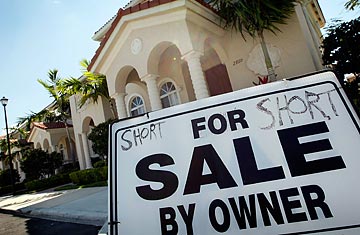
More housing help is on the way. The Obama Administration rolled out a batch of plans on Tuesday, including one designed to make it easier for struggling homeowners to catch a break on second mortgages like home-equity loans.
Like the broader Making Home Affordable housing plan announced on Feb. 18, the new effort involves the Federal Government giving money to mortgage servicers when they lower homeowners' monthly payments — and to borrowers when they keep paying their loans and don't walk away.
See the world's most influential people in the 2009 TIME 100.
The incentive payments to modify second mortgages are meant to address a major omission in the original housing plan. Some 50% of at-risk mortgages carry second liens, but before today's announcement, there was no systematic way to deal with that pot of money owed.
Under the original plan, mortgage servicers were paid to reduce homeowners' monthly payments to as little as 31% of gross income — but that only covered first mortgages. This seriously alarmed some investors in mortgage-related securities, since many second mortgages are owned by the same companies that service the loans. The companies were essentially getting paid to trim the amount owed to outside investors while not necessarily taking a haircut themselves.
Now when a participating servicer changes the terms of a first mortgage, it will also have to reduce the interest rate on the second lien — to either 1% or 2%. The government will pay for half of the loss incurred by the loan owners, from the $50 billion bucket of money it had already pledged to housing-rescue programs. Mortgage servicers will be paid to make the change, and homeowners have their first-mortgage principal reduced as long as they stay current — by up to $250 a year for five years.
Since the Administration's announcement on March 4 of the specifics of its original plan, 11 servicers, which handle some 75% of the mortgages in the U.S., have signed up to participate. The Administration expects those same servicers to sign up for the second-lien add-on as well. It should be up and running in about a month. (Read "Housing Takes Center Stage As Economy Looks for Signs.")
While precise numbers don't exist, anecdote suggests that not too many loans have been restructured under the original plan thus far. That, though, could largely be due to the complexity of implementing a new process — it takes time to change computer systems and train employees. CitiMortgage, the home-lending arm of Citigroup, officially began offering government-backed modifications only on April 23.
During the first few weeks of April, Chase Home Finance, a division of JPMorgan Chase, initiated some 10,000 loan modifications under the Adminstration's plan. But that was at a slightly lower pace than what the company had been doing under its own modification initiatives. "We're working through the pipeline and we're going to see much bigger numbers," says spokesman Tom Kelly. "There are financial incentives now for everyone to make this work. It's a huge stride over what was already out there."
More concrete success can be seen in another part of the Administration's original plan. The government has made it possible for homeowners with little or no equity to refinance into cheaper loans — a particularly tough trick to pull off with tighter lending standards. Loans owned or guaranteed by Fannie Mae or Freddie Mac qualify; the two government-sponsored entities cover more than half of mortgages in the U.S. In the first three weeks of the program, Freddie Mac closed about 1,000 of these refinances, though "that's a drop in the bucket compared to what's expected," says Patricia McClung, a Freddie Mac vice president in charge of new products for single-family homes. "The lenders are still putting this in place." (Read a brief history of Fannie Mae and Freddie Mac.)
With mortgage rates near all-time lows, interest in this program is running extremely high. In the first few weeks of April, Fannie Mae had 1.2 million homeowners check its website to see if their mortgages qualified. During that time, Fannie received some 22,000 refinance applications from people who owe between 80% and 105% of the value of their home — the group the plan targets. A Fannie spokeswoman couldn't comment on how many of those had closed.
More information about both prongs of the housing plan can be found at MakingHomeAffordable.gov.
